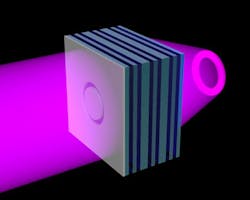Scientists build simple UV-focusing metamaterial flat lens
Gaithersburg, MD--A team of U.S. and Canadian scientists has created an easily fabricated spray-on flat thin-film metamaterial lens that works at UV wavelengths.1 The team includes scientists from the National Institute of Standards and Technology (NIST), the University of Maryland (College Park, MD), Syracuse University (Syracuse, NY), and the University of British Columbia (Kelowna, BC, Canada).
One-to-one 3D imaging
Because the metamaterial has a refractive index of -1, it creates an unusual sort of image in which light from every point on one side of the lens is focused to a corresponding point on the other side of the lens that is exactly the same distance away from the lens, and also has the same lateral position; so, for example, if the lens itself is a plane at z = 0, an object point at (x, y, z) gets imaged to (x, y, -z). The result is a 3D mirror image of the object, always at unity magnification and without lens aberrations. Also, as a result, the lens has no optical axis and could in theory be made into an arbitrarily large sheet and still create images of the same high quality.
Related: Bilayer metamaterial lens breaks the diffraction limit
The UV lens, which has both negative electric permittivity and negative magnetic permeability, could lead to improved photolithography, nanoscale manipulation and manufacturing, and high-resolution 3D imaging.
"Conventional lenses only capture two dimensions of a three-dimensional object," says one of the paper's co-authors, NIST's Ting Xu. "Our flat lens is able to project three-dimensional images of three-dimensional objects that correspond one-to-one with the imaged object."
For the past decade, scientists have made metamaterials that work at microwave, infrared and visible wavelengths by fabricating repeating metallic patterns on flat substrates. However, the smaller the wavelength of light scientists want to manipulate, the smaller these features need to be, which makes fabricating the structures an increasingly difficult task. Until now, making metamaterials that work in the UV has been impossible because it required making structures with features as small as 10 nm.
The NIST researchers and their colleagues took inspiration from a theoretical metamaterial design recently proposed by a group at the FOM Institute for Atomic and Molecular Physics in Holland, adapting the design to work in the UV.
According to NIST researchers Ting Xu, Amit Agrawal, and Henri Lezec, aside from achieving record-short wavelengths, the metamaterial lens is inherently easy to fabricate. It doesn't rely on nanoscale patterns, but instead is a simple sandwich of alternating nanometer-thick layers of silver and titanium dioxide, the construction of which is routine. And because its unique design consists of a stack of strongly coupled waveguides sustaining backward waves, the metamaterial exhibits a negative index of refraction to incoming light regardless of its angle of travel.
The metamaterial flat lens achieves its refractive action over a distance of about two wavelengths of UV light, making possible small image distances that are challenging to achieve with conventional refractive optics such as glass lenses. Furthermore, transmission through the metamaterial can be turned on and off using higher-frequency light as a switch, allowing the flat lens to also act as a shutter with no moving parts.
REFERENCE:
1. T. Xu et al., Nature, 497, p. 470 (2013); published online: May 23. 2013. doi:10.1038/nature12158

John Wallace | Senior Technical Editor (1998-2022)
John Wallace was with Laser Focus World for nearly 25 years, retiring in late June 2022. He obtained a bachelor's degree in mechanical engineering and physics at Rutgers University and a master's in optical engineering at the University of Rochester. Before becoming an editor, John worked as an engineer at RCA, Exxon, Eastman Kodak, and GCA Corporation.
